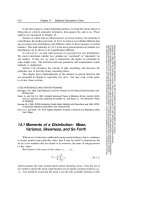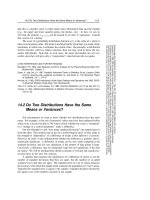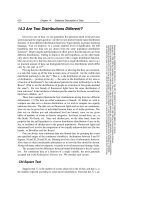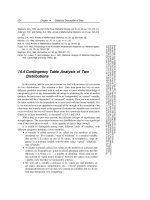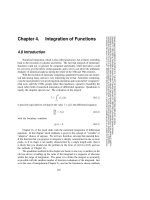Statistical Description of Data part 3
Bạn đang xem bản rút gọn của tài liệu. Xem và tải ngay bản đầy đủ của tài liệu tại đây (121.32 KB, 6 trang )
14.2 Do Two Distributions Have the Same Means or Variances?
615
Sample page from NUMERICAL RECIPES IN C: THE ART OF SCIENTIFIC COMPUTING (ISBN 0-521-43108-5)
Copyright (C) 1988-1992 by Cambridge University Press.Programs Copyright (C) 1988-1992 by Numerical Recipes Software.
Permission is granted for internet users to make one paper copy for their own personal use. Further reproduction, or any copying of machine-
readable files (including this one) to any servercomputer, is strictly prohibited. To order Numerical Recipes books,diskettes, or CDROMs
visit website or call 1-800-872-7423 (North America only),or send email to (outside North America).
that this is wasteful, since it yields much more information than just the median
(e.g., the upper and lower quartile points, the deciles, etc.). In fact, we saw in
§8.5 that the element x
(N+1)/2
can be located in of order N operations. Consult
that section for routines.
The mode of a probability distribution function p(x) is the value of x where it
takes on amaximum value. The modeisuseful primarilywhenthereisa single, sharp
maximum, in which case it estimates the central value. Occasionally, a distribution
will be bimodal, with two relative maxima; then one may wish to know the two
modes individually. Note that, in such cases, the mean and median are not very
useful, since they will give only a “compromise” value between the two peaks.
CITED REFERENCES AND FURTHER READING:
Bevington, P.R. 1969,
Data Reduction and Error Analysis for the Physical Sciences
(New York:
McGraw-Hill), Chapter 2.
Stuart, A., and Ord, J.K. 1987,
Kendall’s Advanced Theory of Statistics
, 5th ed. (London: Griffin
and Co.) [previous eds. published as Kendall, M., and Stuart, A.,
The Advanced Theory
of Statistics
], vol. 1,
§
10.15
Norusis, M.J. 1982,
SPSS Introductory Guide: Basic Statistics and Operations
; and 1985,
SPSS-
X Advanced Statistics Guide
(New York: McGraw-Hill).
Chan, T.F., Golub, G.H., and LeVeque, R.J. 1983,
American Statistician
, vol. 37, pp. 242–247. [1]
Cram´er, H. 1946,
Mathematical Methods of Statistics
(Princeton: Princeton University Press),
§
15.10. [2]
14.2 Do Two Distributions Have the Same
Means or Variances?
Not uncommonly we want to know whether two distributions have the same
mean. For example, a first set of measured values may have been gathered before
some event, a second set after it. We want to know whether the event, a “treatment”
or a “change in a control parameter,” made a difference.
Our first thought is to ask “how many standard deviations” one sample mean is
from the other. That number may in fact be a useful thing to know. It does relate to
the strength or “importance” of a difference of means if that difference is genuine.
However, by itself, it says nothing about whether the difference is genuine, that is,
statistically significant. A difference of means can be very small compared to the
standard deviation, and yet very significant, if the number of data points is large.
Conversely, a difference may be moderately large but not significant, if the data
are sparse. We will be meeting these distinct concepts of strength and significance
several times in the next few sections.
A quantity that measures the significance of a difference of means is not the
number of standard deviations that they are apart, but the number of so-called
standard errors that they are apart. The standard error of a set of values measures
the accuracy with which the sample mean estimates the population (or “true”) mean.
Typically the standard error is equal to the sample’s standard deviation divided by
the square root of the number of points in the sample.
616
Chapter 14. Statistical Description of Data
Sample page from NUMERICAL RECIPES IN C: THE ART OF SCIENTIFIC COMPUTING (ISBN 0-521-43108-5)
Copyright (C) 1988-1992 by Cambridge University Press.Programs Copyright (C) 1988-1992 by Numerical Recipes Software.
Permission is granted for internet users to make one paper copy for their own personal use. Further reproduction, or any copying of machine-
readable files (including this one) to any servercomputer, is strictly prohibited. To order Numerical Recipes books,diskettes, or CDROMs
visit website or call 1-800-872-7423 (North America only),or send email to (outside North America).
Student’s t-test for Significantly Different Means
Applying the concept of standard error, the conventional statistic for measuring
the significance of a difference of means is termed Student’s t. When the two
distributions are thought to have the same variance, but possibly different means,
then Student’s t is computed as follows: First, estimate the standard error of the
difference of the means, s
D
, from the “pooled variance” by the formula
s
D
=
i∈A
(x
i
− x
A
)
2
+
i∈B
(x
i
− x
B
)
2
N
A
+ N
B
− 2
1
N
A
+
1
N
B
(14.2.1)
where each sum is over the points in one sample, the first or second, each mean
likewise refers to one sample or the other, and N
A
and N
B
are the numbers of points
in the first and second samples, respectively. Second, compute t by
t =
x
A
− x
B
s
D
(14.2.2)
Third, evaluate the significance of this value of t for Student’s distribution with
N
A
+ N
B
− 2 degrees of freedom, by equations (6.4.7) and (6.4.9), and by the
routine betai (incomplete beta function) of §6.4.
The significance is a number between zero and one, and is the probability that
|t| could be this large or larger just by chance, for distributions with equal means.
Therefore, a small numerical value of the significance (0.05 or 0.01) means that the
observed difference is “very significant.” The function A(t|ν) in equation (6.4.7)
is one minus the significance.
As a routine, we have
#include <math.h>
void ttest(float data1[], unsigned long n1, float data2[], unsigned long n2,
float *t, float *prob)
Given the arrays
data1[1..n1]
and
data2[1..n2]
, this routine returns Student’s t as
t
,
and its significance as
prob
, small values of
prob
indicating that the arrays have significantly
different means. The data arrays are assumed to be drawn from populations with the same
true variance.
{
void avevar(float data[], unsigned long n, float *ave, float *var);
float betai(float a, float b, float x);
float var1,var2,svar,df,ave1,ave2;
avevar(data1,n1,&ave1,&var1);
avevar(data2,n2,&ave2,&var2);
df=n1+n2-2; Degrees of freedom.
svar=((n1-1)*var1+(n2-1)*var2)/df; Pooled variance.
*t=(ave1-ave2)/sqrt(svar*(1.0/n1+1.0/n2));
*prob=betai(0.5*df,0.5,df/(df+(*t)*(*t))); See equation (6.4.9).
}
which makes use of the following routine for computing the mean and variance
of a set of numbers,
14.2 Do Two Distributions Have the Same Means or Variances?
617
Sample page from NUMERICAL RECIPES IN C: THE ART OF SCIENTIFIC COMPUTING (ISBN 0-521-43108-5)
Copyright (C) 1988-1992 by Cambridge University Press.Programs Copyright (C) 1988-1992 by Numerical Recipes Software.
Permission is granted for internet users to make one paper copy for their own personal use. Further reproduction, or any copying of machine-
readable files (including this one) to any servercomputer, is strictly prohibited. To order Numerical Recipes books,diskettes, or CDROMs
visit website or call 1-800-872-7423 (North America only),or send email to (outside North America).
void avevar(float data[], unsigned long n, float *ave, float *var)
Given array
data[1..n]
, returns its mean as
ave
and its variance as
var
.
{
unsigned long j;
float s,ep;
for (*ave=0.0,j=1;j<=n;j++) *ave += data[j];
*ave /= n;
*var=ep=0.0;
for (j=1;j<=n;j++) {
s=data[j]-(*ave);
ep += s;
*var += s*s;
}
*var=(*var-ep*ep/n)/(n-1); Corrected two-pass formula (14.1.8).
}
The next case to consider is where the two distributions have significantly
different variances, but we nevertheless want to know if their means are the same or
different. (A treatment for baldness has caused some patients to lose all their hair
and turned others into werewolves, but we want to know if it helps cure baldness on
the average!) Be suspicious of the unequal-variance t-test: If two distributions have
very different variances, then they may also be substantially different in shape; in
that case, the difference of the means may not be a particularly useful thing to know.
To find out whether the two data sets have variances that are significantly
different, you use the F-test, described later on in this section.
The relevant statistic for the unequal variance t-test is
t =
x
A
− x
B
[Var (x
A
)/N
A
+ Var ( x
B
)/N
B
]
1/2
(14.2.3)
This statistic is distributed approximately as Student’s t with a number of degrees
of freedom equal to
Var (x
A
)
N
A
+
Var (x
B
)
N
B
2
[Var (x
A
) /N
A
]
2
N
A
− 1
+
[Var(x
B
)/N
B
]
2
N
B
− 1
(14.2.4)
Expression (14.2.4) is in general not an integer, but equation (6.4.7) doesn’t care.
The routine is
#include <math.h>
#include "nrutil.h"
void tutest(float data1[], unsigned long n1, float data2[], unsigned long n2,
float *t, float *prob)
Given the arrays
data1[1..n1]
and
data2[1..n2]
, this routine returns Student’s t as
t
,and
its significance as
prob
, small values of
prob
indicating that the arrays have significantly differ-
ent means. The data arrays are allowed to be drawn from populations with unequal variances.
{
void avevar(float data[], unsigned long n, float *ave, float *var);
float betai(float a, float b, float x);
float var1,var2,df,ave1,ave2;
618
Chapter 14. Statistical Description of Data
Sample page from NUMERICAL RECIPES IN C: THE ART OF SCIENTIFIC COMPUTING (ISBN 0-521-43108-5)
Copyright (C) 1988-1992 by Cambridge University Press.Programs Copyright (C) 1988-1992 by Numerical Recipes Software.
Permission is granted for internet users to make one paper copy for their own personal use. Further reproduction, or any copying of machine-
readable files (including this one) to any servercomputer, is strictly prohibited. To order Numerical Recipes books,diskettes, or CDROMs
visit website or call 1-800-872-7423 (North America only),or send email to (outside North America).
avevar(data1,n1,&ave1,&var1);
avevar(data2,n2,&ave2,&var2);
*t=(ave1-ave2)/sqrt(var1/n1+var2/n2);
df=SQR(var1/n1+var2/n2)/(SQR(var1/n1)/(n1-1)+SQR(var2/n2)/(n2-1));
*prob=betai(0.5*df,0.5,df/(df+SQR(*t)));
}
Our final example of a Student’s t test is the case of paired samples.Here
we imagine that much of the variance in both samples is due to effects that are
point-by-point identical in the two samples. For example, we might have two job
candidates who have each been rated by the same ten members of a hiring committee.
We want to know if the means of the ten scores differ significantly. We first try
ttest above, and obtain a value of prob that is not especially significant (e.g.,
> 0.05). But perhaps the significance is being washed out by the tendency of some
committee members always to give high scores, others always to give low scores,
which increases the apparent variance and thus decreases the significance of any
difference in the means. We thus try the paired-sample formulas,
Cov(x
A
,x
B
)≡
1
N −1
N
i=1
(x
Ai
− x
A
)(x
Bi
− x
B
)(14.2.5)
s
D
=
Var (x
A
)+Var(x
B
) − 2Cov(x
A
,x
B
)
N
1/2
(14.2.6)
t =
x
A
− x
B
s
D
(14.2.7)
where N is the number in each sample (number of pairs). Notice that it is important
that a particular value of i label the corresponding points in each sample, that is,
the ones that are paired. The significance of the t statistic in (14.2.7) is evaluated
for N − 1 degrees of freedom.
The routine is
#include <math.h>
void tptest(float data1[], float data2[], unsigned long n, float *t,
float *prob)
Given the paired arrays
data1[1..n]
and
data2[1..n]
, this routine returns Student’s t for
paired data as
t
, and its significance as
prob
, small values of
prob
indicating a significant
difference of means.
{
void avevar(float data[], unsigned long n, float *ave, float *var);
float betai(float a, float b, float x);
unsigned long j;
float var1,var2,ave1,ave2,sd,df,cov=0.0;
avevar(data1,n,&ave1,&var1);
avevar(data2,n,&ave2,&var2);
for (j=1;j<=n;j++)
cov += (data1[j]-ave1)*(data2[j]-ave2);
cov /= df=n-1;
sd=sqrt((var1+var2-2.0*cov)/n);
*t=(ave1-ave2)/sd;
*prob=betai(0.5*df,0.5,df/(df+(*t)*(*t)));
}
14.2 Do Two Distributions Have the Same Means or Variances?
619
Sample page from NUMERICAL RECIPES IN C: THE ART OF SCIENTIFIC COMPUTING (ISBN 0-521-43108-5)
Copyright (C) 1988-1992 by Cambridge University Press.Programs Copyright (C) 1988-1992 by Numerical Recipes Software.
Permission is granted for internet users to make one paper copy for their own personal use. Further reproduction, or any copying of machine-
readable files (including this one) to any servercomputer, is strictly prohibited. To order Numerical Recipes books,diskettes, or CDROMs
visit website or call 1-800-872-7423 (North America only),or send email to (outside North America).
F-Test for Significantly Different Variances
The F-test tests the hypothesis that two samples have different variances by
trying to reject the null hypothesis that their variances are actually consistent. The
statistic F is the ratio of one variance to the other, so values either 1 or 1
will indicate very significant differences. The distribution of F in the null case is
given in equation (6.4.11), which is evaluated using the routine betai.Inthemost
common case, we are willing to disprove the null hypothesis (of equal variances) by
either very large or very small values of F, so the correct significance is two-tailed,
the sum of two incomplete beta functions. It turns out, by equation (6.4.3), that the
two tails are always equal; we need compute only one, and double it. Occasionally,
when the null hypothesis is strongly viable, the identity of the two tails can become
confused, giving an indicated probabilitygreater than one. Changingthe probability
to two minus itself correctly exchanges the tails. These considerations and equation
(6.4.3) give the routine
void ftest(float data1[], unsigned long n1, float data2[], unsigned long n2,
float *f, float *prob)
Given the arrays
data1[1..n1]
and
data2[1..n2]
, this routine returns the value of
f
,and
its significance as
prob
. Small values of
prob
indicate that the two arrays have significantly
different variances.
{
void avevar(float data[], unsigned long n, float *ave, float *var);
float betai(float a, float b, float x);
float var1,var2,ave1,ave2,df1,df2;
avevar(data1,n1,&ave1,&var1);
avevar(data2,n2,&ave2,&var2);
if (var1 > var2) { Make F the ratio of the larger variance to the smaller
one.*f=var1/var2;
df1=n1-1;
df2=n2-1;
} else {
*f=var2/var1;
df1=n2-1;
df2=n1-1;
}
*prob = 2.0*betai(0.5*df2,0.5*df1,df2/(df2+df1*(*f)));
if (*prob > 1.0) *prob=2.0-*prob;
}
CITED REFERENCES AND FURTHER READING:
von Mises, R. 1964,
Mathematical Theory of Probability and Statistics
(New York: Academic
Press), Chapter IX(B).
Norusis, M.J. 1982,
SPSS Introductory Guide: Basic Statistics and Operations
; and 1985,
SPSS-
X Advanced Statistics Guide
(New York: McGraw-Hill).


